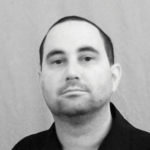Jason James (AUS)

If you feel confused by the world around you then Therapy TM can help you. To remove the social stigma associated with seeing a therapist we have turned it in to a game. This way you can get help and have fun at the same time. For a limited time it is even free!
Jason James is a Tasmanian based artist, lighting designer, video designer, curator, teacher, technician, production manager, rigger, musician, father, student, tinker, performer, improviser, stage manager, database developer, curator, network administrator (retired), vision systems operator, lighting operator, sound engineer, gamer, and forum administrator. Recent artworks include Instill v1, v2, and v3 (Live Art at Light Box Gallery, Peacock Theatre, Old Hobart Penitentiary Chapel), Death of the Actroid (solo exhibition at Rat Palace Pop Up Gallery), Lego Head on Statue of David (Penny Contemporary Artists for Bushfire Relief), Bulb (with Scott Cotterell at Kelly’s Garden), and Kill Machine (group exhibition at Inflight for Touchy Feely). Recent lighting design credits include Shadow Dreams Terrapin Puppet Theatre, The Shipwright and the Banshee Joshua Santospirito and Chris Downes, The Barbarians IHOS Opera, Hungry For You Extended Play Projects (Lighting and Video Design), and Sleeping Horses Lie Terrapin Puppet Theatre.
Responding Artist
www.mediamixed.com
I am responding to the different elements in NAF:TMFC . They were the exhibition, the opening events, the workshop, and the closed feedback sessions. Each played a part in the work that I produced for Notorious R&D and each affected me differently as an artist. I will address each part separately then consider it as a whole.
I found the workshop very inspiring. I have had an on and off connection to the command line since my days as a young teenager programming Amiga computers. When that platform died I lost some faith in learning command line. Amiga was based on UNIX and had a similar shell. At that stage I should have changed to UNIX rather than Windows, but UNIX was not available to me. What really happened was that I quit using computers all together. It wasn’t until I started working in theatre companies and they needed help with Macs that I started using computers again. Over the years I have had a go at installing Linux and playing around with them. But the lack of support for sound and graphics was a stalling point. The workshop has encouraged me to see Linux as viable for development of my arts/ technology projects. I had wanted to for years, but not yet made the jump. This workshop has given me that bump. I put together a Linux system for Notorious R&D and installed Linux Virtual Machines on all six of my Windows computers. I had done the software development for my work in Windows then changed to using Linux for it and what I feared would take a long time took less, and worked first time.
I was challenged by the exhibition in terms of how much a computer game came be considered art. I loved the grenade that sniffed networks for photos. In its own way it was a game; the game of stealing people’s data. It is the same game that corporations play every day. I tried to connect with the MUD, but was not able to. I learned something about the failure of game art if it is too complicated. The two games that used a 3D engine were also interesting to me. Normally I see games as developed by large teams of people over years. Here were artists making games by themselves. It was very encouraging for me. I have always wanted to make games with artistic integrity but have seen it as too hard. When I was talking to one of the 3D game artists they told me that it took two months to learn then six months to make. They also encouraged me to try it.
The talks and events were interesting and engaging. I did have trouble maintaining concentration on some of the talks after an entire day of workshops. As a result of this the talk at Art Forum by Florian Cramer was the most interesting for me. My attention was also split by needing to work as a technician on the event; this engaged me with the event and disengaged me from the content.
I thought it was excellent that one of the international artists was able to be there for one of the closed feedback sessions. I found the feedback sessions very useful. Generally I make art without structured discourse about it. From these sessions I also gained some insight to gallery practice. I was particularly struck by the need to avoid the ‘salad spinner’ effect of having all works against the wall. Because of this I made a point of disconnecting my work from the wall when I would normally have put it against it.
I found communication with the curator and CAST to be open and reasonable. In comparison to another arts project I was working on at the same time this was a pleasure.
Therapy TM (EMO)
Artist Text Response
Therapy TM (EMO)
Photo Aaron Horsley
Therapy TM (EMO) screenshot
Image courtesy of the artist